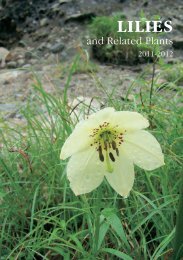LILIES - RHS Lily Group
LILIES - RHS Lily Group
LILIES - RHS Lily Group
Create successful ePaper yourself
Turn your PDF publications into a flip-book with our unique Google optimized e-Paper software.
ees and butterflies in the air, and steppe ravines become white and rosy like<br />
a bride. Among thickets of shrubs and low trees a dense multi-coloured carpet<br />
of Corydalis bulbosa and Corydalis marschalliana, Scilla sibirica and Tulipa<br />
biebersteiniana appears. In open places the spring steppe is a delicate crisp<br />
green, with spots of yellow and red Shrenk’s tulips, multi-coloured irises (Iris<br />
pumila, Iris halophila), Fritillaria ruthenica and Adonis wolgensis.<br />
They are followed at the end of spring by the fragrant salvias that come into<br />
flower: Salvia tesquicola, S. nutans, S. aethiopica, and perennial and arboreal<br />
astragaluses. Salvia tesquicola can turn the steppe lilac-blue. In the birch groves<br />
on sand hills orchids begin to flower in May. May to the beginning of June is the<br />
period of mass and profuse flowering of many plants of the steppe. Somewhat<br />
later the wild strawberry (Fragaria viridis) begins to ripen on the chalk hills and<br />
steppe ravines. Wether its crop is profuse or berries burnt by the sun, depends<br />
on summer rains. In July the steppe becomes yellow and dry, staying thus till the<br />
first autumnal rains.<br />
The middle of the hot summer is the time to look at the flowering plants of<br />
the water meadows. On the banks of numerous large and small lakes the high<br />
perennial Senecio tataricum is seen from far away because of its large yellow<br />
flowers, together with pink spikes of Lythrum salicaria and Lythrum virgata.<br />
At the end of summer the number of flowers diminishes considerably, but in<br />
autumn the steppe again becomes colourful. Leaves of Euonymus verrucosus<br />
turn to bright red and create the effect of burning fires here and there against<br />
the chalk hills. Yellow leaves of Acer campestre decorate the autumnal forest<br />
against a background of black and grey tree trunks and whitish slopes of chalk<br />
ravines. This is a period of seeds ripening, though the seeds of many ephemeroid<br />
bulbs had ripened at the beginning of summer. Some high grasses from the<br />
Apiaceae family form specific communities and remind one of the more familiar<br />
high grasslands of the Far East. Bright berries of Berberis vulgaris, hawthorns<br />
(Crataegus ambigua and C. rhipidophylla) and various rose species (Rosa<br />
corymbifera, R. majalis, R. microdenia, R. rubiginosa) decorate steppe ravines<br />
for a long time. Step by step the tinges of the steppe become more and more<br />
dull and gloomy. In late autumn, before everything is covered in snow, the grey<br />
colour dominates the steppe, but green tinges appear from the fresh grass of the<br />
steppe plants, such as Festuca valesiaca, feather-grasses and bulbous alliums that<br />
begin to grow after the autumnal rains.<br />
Liliaceous and other bulbs of the Lower Khoper<br />
The steppe zone at the southern end of the European part of Russia is much<br />
richer in bulbous plants compared to the forest zone. Bulb plants belong to<br />
several families, Alliaceae and Liliaceae being the richest among them. Below<br />
113




